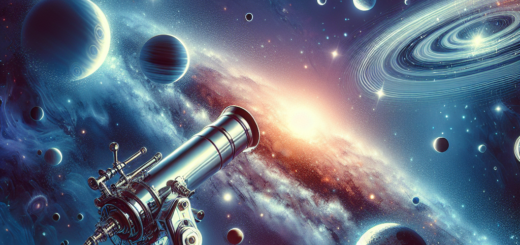NASA’s Kepler Telescope Discovered A New Exoplanet Even Better for Life Than Earth
Over its 9-year mission, NASA’s Kepler Telescope turned its gaze to over half a million stars, revealing that 20-50% of all visible stars could harbor potentially habitable Earth-sized rocky planets. In our relentless search for extraterrestrial neighbors, we’ve already uncovered over 5,500 exoplanets, dozens of which might have conditions suitable for life, and many other planets are so bizarre they capture your imagination. And NASA continues to find new alien worlds almost every day. But recently, scientists have discovered a very strange planet that might not just be habitable, but could have a form of life that turns our entire worldview about life upside down. Now get ready to discover how astronomers found a planet that shouldn’t exist, see another celestial body that is a cosmic mirror, and watch how another planetary system performs an interesting cosmic mathematical dance, and much more… [LOGO] Many studies have been done and concluded that life has more chances to emerge around red dwarfs than stars like our Sun. And there are more red dwarfs than any other type of star in the universe. Red dwarfs are also the smallest type of hydrogen-burning star. In 2023, astronomers stumbled across an intriguing exoplanet around the red dwarf star TOI-715 located in the constellation of Volans 136 light-years away from us. Astronomically speaking, this is in our celestial neighborhood, like a house just down the block from where we live. The red dwarf star TOI-715 is orbited by the super-Earth planet TOI-715 b. What defines an exoplanet as a super-Earth is its mass, which has to surpass that of Earth. TOI-715 b is 3 times as massive as our planet, and it is about 1.5 times the Earth’s radius. To even consider a space object habitable, among all other things, it has to be either a water world or a rocky planet. By analyzing the exoplanet’s parameters, scientists can make predictions about its composition, determining whether it falls into the category of a gaseous, rocky, or watery world. Usually, planets that are between 2 and 10 Earth masses, and a diameter between that of our planet and Neptune turn out to be rocky. But it’s not only the exoplanet’s mass and size that make it special. Located at just the right distance from its star, TOI-715 b receives enough heat to possibly have liquid water on its surface. And where there’s water, there could be life. Red dwarfs like TOI-715 often have several worlds tightly packed within their habitable zone. Astronomers theorize that there could be one more planet in the system [TOI-715 c] just about 7% larger than Earth. If the theory holds true, it will be the smallest exoplanet ever discovered in the habitable zone by NASA’s Transiting Exoplanet Survey Satellite. In our cosmic quest to find habitable worlds, planets like TOI-715 b seem to be our best contenders. Despite our limited knowledge about this newfound exoplanet and its potential neighbors, imagine the excitement if future observations uncover an atmosphere, and even bodies of liquid on its surface like those we have once spotted on Saturn’s largest moon, Titan. The possibilities are thrilling; perhaps one day, our descendants will be navigating vast, uncharted landscapes, seeing the unknown creatures roaming around this alien terrain. But, let’s move on to other recently discovered exoplanets. Unfortunately, not many exoplanets we find are habitable even in theory, some have conditions so terrifying, we wonder how they came to exist. On average, chances of finding an inhospitable exoplanet are much higher, and these planets raise a lot of questions within the scientific community. [264 light-years] One of such celestial marvels sits at a distance of around 264 light-years from Earth [LTT 9779 b]. So what’s so special about it? What you see here is one of the planets called ultra-hot Neptunes [Surface temperature: 3,650°F 2,000°C]. But LTT 9779 b isn’t just that, it’s the most reflective exoplanet we’ve ever detected. The blazing-hot world is roughly 5 times wider than Earth, and it reflects about 80% of the light coming from its star. To compare, Earth only reflects about 30% of sunlight. What makes it a gigantic cosmic mirror is an abundance of reflective clouds of metal, with titanium droplets raining down on its surface. The problem is, as scientists say: “It’s a planet that shouldn’t exist.” The side of the exoplanet that faces its host star is extremely hot; so hot that neither clouds of water nor even clouds of glass or metal should form in its atmosphere. According to our current understanding, a star located this close to an exoplanet should strip away its atmosphere completely. So what happened there? Researchers compared the phenomenon to condensation in a steamy bathroom. If you let the cool air in, water vapor will condense, and if you let the hot water run, eventually, the air will be so full of vapor, it wouldn’t be able to hold any more. Something similar could have happened on this ultra-hot Neptune when the planet’s atmosphere was filled with silicate and metal vapor because of the scorching temperatures on its dayside. But the exoplanet’s uniqueness doesn’t end here. Throughout decades of observations, we’ve detected a multitude of worlds orbiting their host stars in under 1 Earth day, at a very close proximity. But all of them were either ‘hot Jupiters’ 10 times wider than Earth, or rocky planets over 2 times smaller in size than Earth. There was a population of ‘missing planets’ the sizes of which would fit in between these categories. Scientists called this gap ‘The Neptunian desert’. Until finally, we’ve stumbled across LTT 9779 b, which, by its parameters, fits right in the middle. In a way, the exoplanet’s reflectivity is its survival mechanism. If it absorbed much more heat from its star, over time, the planet would slowly evaporate. LTT 9779 b is a perfect target for follow-up observations by the Hubble and the James Webb Space telescopes. Perhaps, our technologies will reveal even more mysteries behind this already enigmatic celestial object in years to come. The planet we’re about to discuss was discovered over a decade ago, but scientists have recently learned something about it that deserves the spot on our list. [637 light-years] WASP-76 b is nearly half as hot [4,350°F 2,400°C] as our Sun, almost twice as wide as Jupiter, but just about 90% its mass. The scorching temperatures are explained by the planet’s close orbit around its star – just about 3% the Earth-Sun distance. Even the closest planet to the Sun – Mercury is located 10 times further away. The place would be a perfect crematorium, since human bones, which primarily consist of calcium, vaporize at approximately 1,500°C. On top of that, one of the planet’s sides is tidally locked to the yellow-white WASP-76 star, which results in different temperatures across the exoplanet and brings about a weird phenomenon. Throughout the years since the planet’s discovery, researchers have studied the composition of the exoplanet, discovering 11 chemical elements in its atmosphere, some of which turned out to be rock-forming, or at least, that’s what happens to them on terrestrial worlds like Earth. But because of the blisteringly hot temperatures on WASP-76 b, elements like magnesium and iron turn into gasses that reside in the planet’s upper atmosphere. And once strong winds carry these iron and magnesium vapors to the night side of the planet, they cool and rain down as molten droplets of metal. It would’ve been a fascinating view to observe, which would probably look something like this. Astronomers have also detected a surprisingly higher amount of nickel in the planet’s atmosphere, which could mean that, in the past, WASP-76 b swallowed a tiny rocky world like Mercury that contained an abundance of this element. Some planets out there in the universe are extremely different from what we have in the solar system, and WASP-76 b isn’t even the most drastic example. [100 light-years] Recently, astronomers uncovered an extraordinary star system just 100 light-years away. Dubbed HD 110067, it contains 6 sub-Neptunes – planets 2-3 times the Earth’s size. All the exoplanets in the system are unusually close to their host star, and with orbits that would fit in between Mercury and the Sun. Unlike our solar system that’s been continuously changing, HD 110067 appears to have maintained its structure for over a billion years. The six planets are synchronized in one perfect celestial dance that scientists call resonance. The way these sub-Neptunes orbit, resembles fractions in a mathematical equation: by the time the first planet completes three orbits, the second world revolves around its star twice. Each subsequent planet follows the rhythm, with the fourth sub-Neptune, for example, orbiting the star four times for every three orbits of the fifth planet, and so on. This discovery is exceptionally rare; usually, young planets maintain these rhythms for a brief period until something goes wrong, like a passing star or more massive planets in the same system, disrupting the balance due to their strong gravitational influence. [1,320 light-years] Over a thousand light-years away, in the constellation Pictor sits a binary star system BEBOP-1. That’s where scientists have recently identified a new member – the exoplanet BEBOP-1c. And it’s not a typical planet as we know them, it belongs to the category called ‘circumbinary planets’, or such that orbit two stars instead of one. They are quite scarce in our cosmic catalog, with only about 15 known so far. But there’s more – it’s the second circumbinary system that hosts more than 1 planet we’ve ever been able to detect. Interestingly, about 85% of stars in the universe aren’t like the Sun – they usually have 1 or more stellar companions. In the Milky Way alone, there are star systems with clusters of 7 stars. Based on our current understanding, single stars only make about 15% of all stars in the cosmos. The newly discovered world is approximately 65 times more massive than Earth, which makes it a gas giant like Jupiter or Saturn. Just imagine how breathtaking it would be to stand on its surface, surrounded by a double-sunrise. Unlike ordinary disks of matter surrounding a single star, in circumbinary systems, the planet-forming disks rotate around both stars, creating disturbances that make it challenging for planets to form. As a result, it’s only in the calm corners away from the stellar chaos that planets have a chance to be born. Discoveries like this remind us of the endless celestial gems we’re still about to uncover, even those that were once purely science fiction. [97 light-years] GJ 9827d is the planet known since 2017, but just recently the Hubble Space Telescope has made an astonishing discovery about this world. The exoplanet is twice the size of Earth and about as hot as Venus [750°F 400°C]. What you would never expect to find there is water – the key ingredient for life as we know it. But fingerprints of water molecules is exactly what the Hubble telescope revealed over 3 years of observations as the planet completed 11 transits – 11 times when it crossed in front of its host star. The atmosphere of GJ 9827b appeared rich in water, and if the measurements are correct, this will be the first time scientists directly prove the existence of worlds with watery atmospheres around stars unlike ours. The planet may have initially formed in a frigid region farther from its star, where low temperatures kept its water in the form of ice. Later, it migrated closer, slowly losing hydrogen due to intense radiation. Or it might have originated close to the hot star in the first place, with traces of water already present in its atmosphere. Although even if that were true, this would still be a steamy-hot world, where life forms we’re familiar with wouldn’t be able to survive. The next step for scientists is to examine data gathered by the James Webb Space Telescope, which will hopefully provide more clarity about the nature of water-rich worlds beyond our solar system. [What does the future of planetary exploration hold?] As for the search for habitable worlds, a recent study suggests a new method to detect such planets based on the role of carbon monoxide [CO] in the atmosphere of exoplanets. When the production of carbon monoxide outruns its removal, something known as CO runaway, it can have an effect on the emergence of life on Earth-like worlds orbiting Sun-like stars. In our Milky Way galaxy, there are potentially 40 billion such planets. By observing atmospheric dynamics of distant worlds, astronomers can focus on best candidates for habitable and even potentially inhabited exoplanets. What other celestial wonders await our discovery? Could there be a real-world planet counterpart for every imaginary planet ever created by the human mind? Let us know in the comments section! Stay tuned here for more exciting space discoveries, and thanks for watching.













